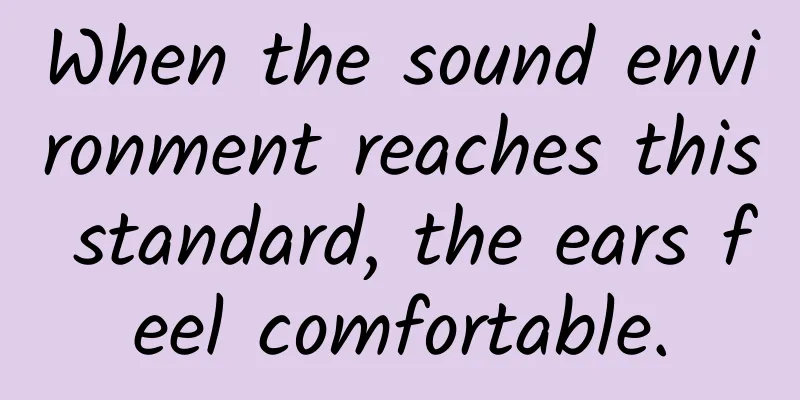When the sound environment reaches this standard, the ears feel comfortable.

|
Produced by: Science Popularization China Produced by: Sun Jin (East China Sea Research Station, Institute of Acoustics, Chinese Academy of Sciences) Producer: Computer Network Information Center, Chinese Academy of Sciences We are often very sensitive to air pollution and light pollution in cities, but have you noticed that while we take care of our eyes and noses, we often ignore the feelings of our ears? If we are always in a noisy road or crowded environment, we will feel physically and mentally exhausted over time; if the living environment is also disturbed by noise, most people will fall into a state of anxiety and emotional instability. Image source: Veer Gallery So, in our daily life in the city, how loud a sound is comfortable for us? What is the minimum sound intensity that the human ear can hear, and what is the maximum sound intensity that can be accepted? How much will the sound intensity be attenuated if we cover our ears with our hands? With these questions, let’s talk about hearing and acoustic environment. If you are nervous when facing the eye chart, try the hearing threshold test First, let’s start with auditory perception. The frequency range of sound waves that the human ear can perceive is 20Hz~20000Hz. Sound waves with a frequency below 20Hz are called infrasound, and sound waves with a frequency above 20000Hz are called ultrasound. Some animals can hear infrasound and ultrasound. For example, elephants can emit and hear infrasound, while bats and dolphins can emit and hear ultrasound. When the sound intensity is very high, infrasound and ultrasound can act on the body through non-auditory pathways. Since the lower natural frequencies of human organs are within the infrasound range, when infrasound acts on the human body, it will produce resonance, causing physiological reactions and pathological changes. High-intensity infrasound can damage human internal organs, so the military has developed infrasound weapons. High-intensity ultrasound can damage human tissues, mainly due to the thermal effect and cavitation effect of ultrasound, the physical basis of which is the mechanical vibration of particles. The dose used in diagnostic ultrasound is much lower than that in therapeutic ultrasound, so it will not cause damage to the human body. The minimum sound intensity that the human ear can perceive (i.e. the average energy density of the sound wave, used to describe the size of the sound) is called the hearing threshold. However, do not mistakenly believe that the hearing threshold is a fixed value. There is no clear boundary between subjective hearing and inaudibility. When the sound intensity is very weak, the subjects can sometimes hear and sometimes not. The author (first from right) conducts pure tone hearing threshold tests for the elderly during the Ear Care Day event (Image source: provided by the author) Therefore, it is difficult to accurately measure the hearing threshold. During clinical testing, researchers will use the minimum hearing level (HL) when the subjects make 50% of the responses as the hearing threshold. The average minimum sound pressure level that young people with normal hearing can hear is defined as hearing level zero, or 0dB HL. In 1997, the World Health Organization (WHO) set the hearing loss classification standard into four levels based on the average air conduction thresholds of 500Hz, 1000Hz, 2000Hz and 4000Hz. The specific classifications are shown in Table 1. Table 1 WHO (1997) hearing loss classification standard (0.5, 1, 2, 4kHz average hearing threshold) (Image source: Reference 4) In 2021, WHO released a new hearing classification standard. Taking into account the different performances of people with hearing loss in noisy and quiet environments, the starting value of mild hearing loss was lowered from 26dB HL to 20dB HL. People with mild hearing loss have no problem talking in a quiet environment, but may not be able to hear the conversation clearly in a noisy environment. The new classification also adds the standard for unilateral hearing loss. The specific classification is shown in Table 2. Table 2 WHO (2021) hearing loss classification standards (0.5, 1, 2, 4kHz average hearing thresholds) (Image source: Reference 4) Be aware of noise in your environment It can be seen from the hearing grading standard that people with normal hearing can hear sounds with a sound intensity of less than 20dB HL, but when the sound intensity reaches 120dB HL, we will feel uncomfortable and unbearable. In the sound environment we live in every day, the sound intensity produced by different sound sources varies: from the smallest whisper to loud conversation, the sound intensity is approximately between 20 and 80dB HL; in the production workshop of the factory, the noise level is often higher than 85dB(A); the sound intensity of the lawn mower can reach 100dB HL; the sound intensity of racing cars, airplanes and firecrackers can reach more than 120dB HL. When using a sound level meter to test the ambient sound intensity level, A-weighting is generally used, and the unit is expressed in dB(A). Here, the ambient sound intensity marked as dB HL is the conversion of dB(A) into hearing level. Sound intensity and frequency distribution of different sound sources (Image source: http://bestlab.shal.ac.cn/301/disanzhang2.html) If a person continues to stay in a sound environment above 85dB(A), it may cause a temporary change in the hearing threshold, and the minimum sound intensity that can be heard will increase. If the person cannot be transferred to a quiet environment in time, the hearing threshold may change permanently, that is, noise-induced hearing loss may occur. In a noisy environment, the greater the sound intensity or the longer the sound persists, the greater the temporary threshold shift it causes. Therefore, some industries must formulate relevant noise standards. For example, the 2016 occupational health operating procedures for the construction industry set health limits for noise exposure, and the maximum noise health limit should not exceed 115dB(A). Table 3 2016 occupational noise exposure hygiene standards for the construction industry (Source: 2016 occupational health operating procedures for the construction industry) Protect your hearing by covering your ears In order to prevent noise from damaging hearing, people who are frequently exposed to noise should remember to wear ear protectors, such as earplugs, earmuffs, noise-proof helmets, etc. Image source: Veer Gallery Regarding the effectiveness of ear protectors, some researchers have tested the sound attenuation values of 18 types of noise-canceling earplugs. The results show that in a noise environment ranging from 125Hz to 8000Hz, the sound attenuation value of the noise-canceling earplugs increases with the increase of frequency; the sound attenuation values at frequencies of 125Hz, 250Hz, and 500Hz are below 20dB; the sound attenuation values at frequencies of 1kHz, 2kHz, 3kHz, 4kHz, 6kHz, and 8kHz are between 20dB and 50dB. It can be seen that the effect of noise-proof earplugs on sound attenuation is relatively limited. However, if the sound intensity reaching the ear can be reduced to below 85dB in daily life, wearing ear protectors can play a protective role. The most common way we use to block noise is to cover our ears with our hands. So, how much sound can the palm of your hand attenuate? Studies have shown that in a noise environment ranging from 125Hz to 8000Hz, when the subjects press the tragus inward to completely close the external auditory canal, the sound attenuation range is between 15 and 45dB. It can be seen that even if we completely block the external auditory canal, we cannot completely attenuate the external sound, so we can usually hear the sound by covering our ears, but the volume is a little lower. However, when we are suddenly exposed to a high-intensity sound environment, covering our ears with our hands can indeed protect our hearing. Keep your voice down and avoid acoustic pollution Nowadays, we are increasingly aware of the importance of sound environment to our physical and mental health. So what is the appropriate level of sound intensity in different sound environments? my country has established acoustic environment quality standards for different types of acoustic environment functional zones. It can be seen that in the Class 0 rehabilitation area, the daytime noise limit is 50dB(A) and the nighttime noise limit is 40dB(A). Only when the noise limit reaches this standard can the acoustic environment conditions for quiet recuperation be achieved. In areas with residential buildings, medical care, culture and education, scientific research and design, and administrative offices as the main functions, the daytime noise limit is 55dB(A) and the nighttime noise limit is 45dB(A). In fact, different life scenes in reality are full of background noise. Studies have shown that the average background noise in a quiet environment is around 40dB(A); in an environment with background music, outdoors, or with radio or television, the average background noise is around 50dB(A); and in shops, train station waiting rooms and platforms, kitchens, car interiors, and environments with multiple people talking, the background noise can reach over 60dB(A). It can be seen that in many environments the background noise can reach over 60dB(A) and the sound quality does not meet the comfort requirements. In order to provide people with a variety of sound environments suitable for physical and mental health, urban builders have made a lot of efforts. For example, in modern architectural design, they focus on using materials with sound insulation and sound absorption functions, and set up green belts and isolation belts on both sides of the road. The maintenance of the acoustic environment requires the joint efforts of workers from all walks of life. For us personally, not making loud noises in public places and obeying the no-honking regulations when driving are very important for the maintenance of the acoustic environment. Let us work together to build a more comfortable acoustic environment! References: 1. Han Demin, Xu Shiang, eds. Fundamentals and Clinical Audiology[M]. Beijing: Science and Technology Literature Press, 2004. 2. Chen Jianming, Cao Cai'e. Infrasound damage to human body and its prevention and treatment[J]. Avant-garde Journal of Medicine, 1997, 14(3): 132-133. 3. Liu Biyue, Lu Kai. The necessity of implementing strong inspection on medical ultrasound equipment from the perspective of the impact of ultrasound on the human body. Metrology and Testing Technology, 2001,5:45-48. 4. Ji Fei, He Yaqi. Application of hearing loss classification and average hearing threshold[J]. Chinese Journal of Hearing and Speech Rehabilitation, 2021, 19(3): 227-230. 5. Gu Yingying. Research and application of spectral characteristics of noise reduction effect of noise-proof earplugs[D]. Wuhan: Wuhan University of Science and Technology, 2013. 6. Yuan Shuli, Chang Jizeng, Gao Xiaoli, et al. Sound attenuation caused by pressing the tragus to completely close the external auditory canal and its development and utilization prospects [J]. Occupational Health and Emergency Rescue, 2008, 26(3): 158-159. 7. GB 3096-2008, Acoustic Environment Quality Standard[S]. Beijing: China Environmental Science Press, 2008. 8. Smeds K, Wolters F, Rung M. Estimation of signal-to-noise ratios in realistic sound scenarios [J]. Journal of American Academy of Audiology, 2015, 26(2): 183-196. |
Recommend
Complete template for advertising planning!
Today I will share with you how to plan the place...
There is no duck in the duck blood for hot pot? 15 types of duck blood were tested, and the results were unexpected!
After testing the authenticity of mutton skewers ...
Google Fiber's 1Gbps Internet speed is accused of hype
According to foreign media reports, the tradition...
Pinduoduo Product Analysis Report
In the market structure where Alibaba and JD.com ...
Who will get a share of the 100 billion yuan terminal subsidies in 2016?
Source: NetEase Technology Original title: "...
What is the universe like? Here is the answer you want
An unforgettable olfactory experience What does s...
Which came first, the chicken or the egg? Maybe the dinosaur egg came first!
There is a legendary "dark cuisine". So...
Android performance optimization: 35% faster startup
1. Introduction As the project version iterates, ...
Case analysis: How are promotional marketing activities planned and implemented?
Next, let’s talk about the design forms of market...
Can eating chili peppers speed up the recovery of oral ulcers?
Recently, some netizens claimed that if you want ...
In-depth analysis | How did the 400 million yuan worth of advertising and content of "The Debaters" come together so perfectly?
There is a variety show that inserts advertisemen...
Will the digital revolution destroy the middle class?
Tablet computers , smartphones and other electron...
7 successful startups teach you how to use social media for marketing!
Written by: Sujan Patel With over 12 years of dig...
Xbox One Chinese pricing criticized: Microsoft lacks sincerity
After 14 years of waiting, Xbox finally unveiled i...
Who was the first person to discover global warming? The answer is…丨Hand-drawn weather
March 23rd of each year is World Meteorological D...









